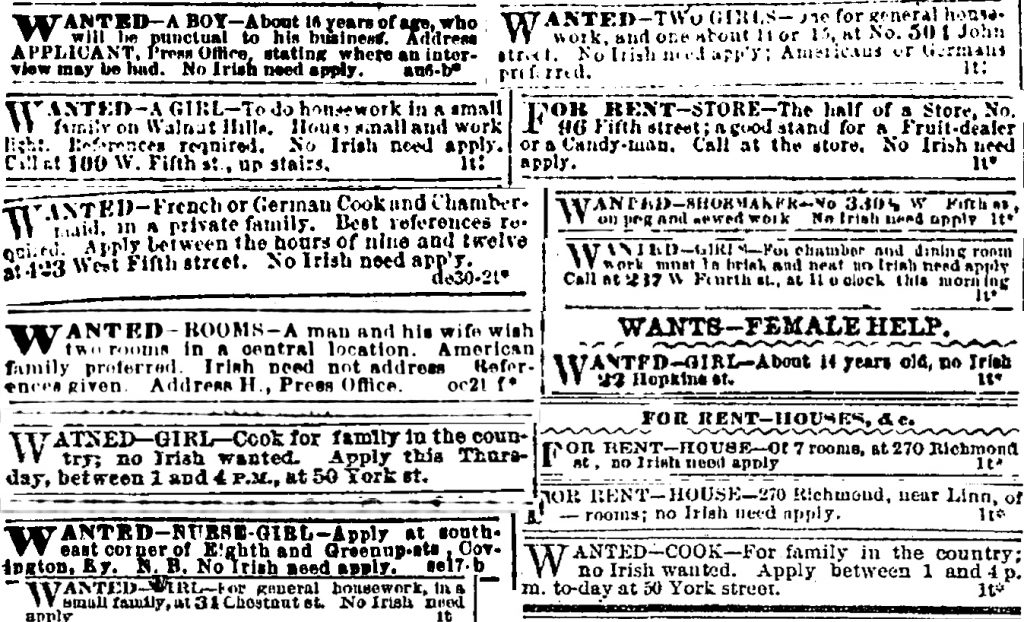It was a stormy December evening in 1867, but the weather failed to prevent hundreds of outraged Cincinnatians from assembling at Mozart Hall. In a session as tumultuous as the deluge outside, the assembly approved a resolution condemning England for imprisoning naturalized American citizens on charges of treason against their former homeland by participating in an Irish uprising.

Photograph courtesy of Greg Hand
Among the orators that night was attorney Milton Sayler, who enthused about the worthiness of America’s adopted citizens. Sayler specifically noted that many of the imprisoned Irish-Americans had served valiantly during the Civil War. “In the dark days of 1862, ’63 and ’64, when … the whole North was called into the field to protect the flag of this country … I recollect then the recruiting offices in this city. I recollect Col. Jones’s office. There was no sign up over Jones’s office saying that no Irish need apply.”
Attorney Sayler referred, of course, to signs that did appear in Cincinnati around that time. From about 1855 to about 1895, it was quite common for employment advertisements in Cincinnati to specify, “No Irish Need Apply.” The phrase was so prevalent that popular songs by that title entertained vaudeville audiences. Although other ethnic groups were beginning to migrate into the Ohio Valley—notably Italians, Jews, Poles, and Hungarians—Cincinnati advertisements did not attempt to discourage any other group except the Irish from applying for jobs.
Irish immigrants began arriving here along with a great wave of Germans around 1848. The Germans landing at that time had fled the failed 1848 revolutions throughout the tottering feudal empires of Europe, while the Irish emigrated to escape the deadly Potato Famine. Throughout the 1800s, German immigrants accounted for as much as one-third of Cincinnati’s total population, but the Irish constituted more than 10 percent—and reaching nearly 15 percent in some censuses.
As the destination of so many immigrants, Cincinnati was heavily involved in spawning a reactionary movement officially named the Native American Party but popularly labeled the “Know Nothings.” This political organization, which enjoyed great success in the 1850s, particularly despised Roman Catholicism, a religion espoused by almost all the Irish immigrants and many Germans. It was around the pinnacle of Know Nothing power that the “No Irish Need Apply” tags began appearing around Cincinnati.
It is difficult to generalize among such large populations, but the Irish immigrants often pursued less-skilled occupations compared to immigrants from Germany. In fact, it was often the case that Irish workers attacked African-American laborers competing for the same jobs in Cincinnati. A vicious riot here in 1862 grew out of Union Army successes in the Civil War. As Northern militias pushed southward, they freed large numbers of slaves, who rushed northward as quickly as they could manage. Arriving in Cincinnati, the freed slaves, who commanded much smaller salaries, quickly took over jobs that had been held by Irish immigrants. At the Burnet House hotel, for example, 50 Irish chambermaids were replaced overnight by African Americans. According to historian Frank L. Klement, Irish aggravation erupted into violence:
“On July 15, Irish workers drove newly-hired blacks off boats and docks. The rioting spread and the Irish-Americans invaded ‘Shantytown’ or ‘Bucktown,’ terms applied to the section of the city inhabited by black residents. The riotous Irish put some homes to the torch and beat up every black man who did not flee. Blacks retaliated by burning some buildings in ‘Dublin,’ the Irish section of the city.”
The adjacent, if antagonistic, relationship between Irish and black workers suggests that anti-Irish sentiments were closely related to the prejudice and segregation endured by African Americans. Native-born Americans, in other words, lumped both groups in the same category and treated them similarly. It’s notable that relatively few advertisements specified that no African Americans need apply because, unless the ad specifically invited black applicants, it was understood that only whites could apply.
The Irish historically used any mechanism available to separate themselves from African Americans, whether physically segregated neighborhoods, religious affiliation, or politics. For more than a century, Irish Catholics constituted a pillar of the segregationist Democratic Party. The feeling was mutual. The Cincinnati Enquirer [July 4, 1868] reported a Chicago newspaper advertisement reading:
“Wanted – In a respectable colored family, a white woman to do general housework. Apply at 73 Carroll Street. No Irish need apply.”
By 1910, The Enquirer (at that time a Democratic newspaper) published a paean to Irish Americans, noting that the once offensive signs discriminating against the Irish were now collectors’ items:
“But each recurring 17th of March serves to recall to us some important facts in connection with the Irish; for instance, that there are no longer notices in the newspapers or signs out that ‘No Irish need apply.’ It happens that we hunt them up now.”
Still, the sting of that discrimination persisted. The formidable Marianne O’Reagan, doyen of The Cincinnati Post’s editorial pages, recalled meeting as a young reporter with one of Cincinnati’s high-society ladies, who, upon learning of O’Reagan’s Irish ancestry, commented that she had never met anyone of Irish ancestry outside her own kitchen. O’Reagan commented:
“The ‘No Irish Need Apply’ signs might have been down in Cincinnati in the 1950s, when the exchange took place, but the memory certainly lingered on.”





Facebook Comments